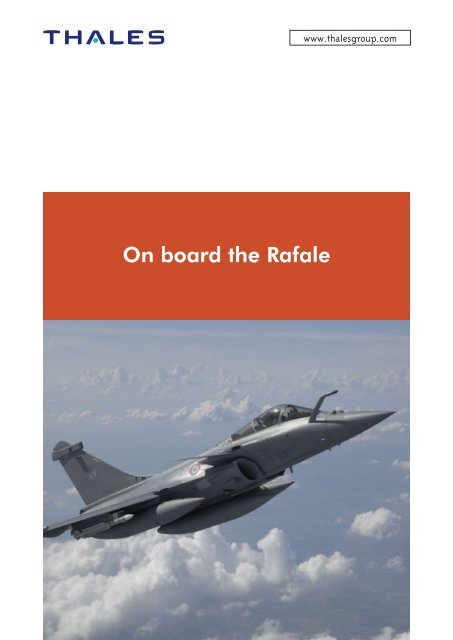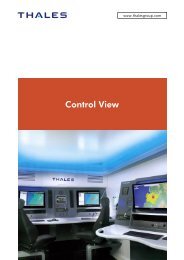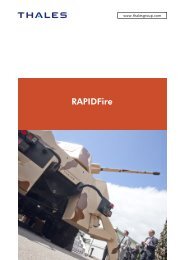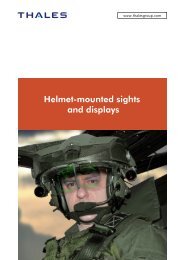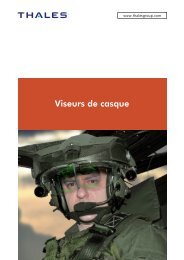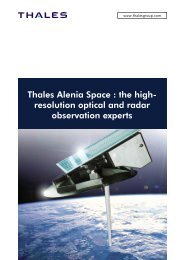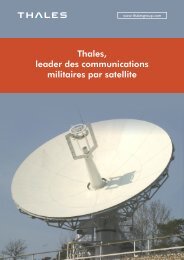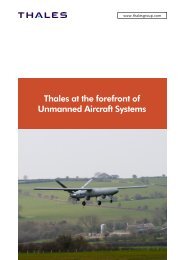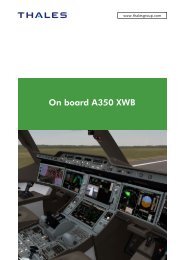On board the Rafale - Thales Group
On board the Rafale - Thales Group
On board the Rafale - Thales Group
- No tags were found...
You also want an ePaper? Increase the reach of your titles
YUMPU automatically turns print PDFs into web optimized ePapers that Google loves.
<strong>On</strong> <strong>board</strong> <strong>the</strong> <strong>Rafale</strong>www.thalesgroup.com
<strong>Thales</strong> is very proud to be on <strong>board</strong> <strong>the</strong> <strong>Rafale</strong> and to have worked alongside Dassault and o<strong>the</strong>r industrybodies to tailor <strong>the</strong> very latest technological innovations to meet <strong>the</strong> needs of this superior aircraft.Omnirole FighterThe <strong>Rafale</strong> is <strong>the</strong> most advanced combat aircraft ofits generation, delivering multi-mission capability thatensures its war fighting relevance beyond 2040. Thishighly agile fighter from Dassault Aviation is equippedwith cutting edge technologies that make it fast deploying,self-supporting and combat effective. The <strong>Rafale</strong> draws onsophisticated on <strong>board</strong> electronic systems to carry out awide range of missions day or night and in all wea<strong>the</strong>rconditions.<strong>Thales</strong> provides equipment and systems – includingavionics – that toge<strong>the</strong>r account for about 25% of <strong>the</strong> totalvalue of each <strong>Rafale</strong>. The <strong>Rafale</strong> is integrated with <strong>the</strong>largest and most modern range of sensors by means of<strong>the</strong> multi-sensor data fusion concept that allows <strong>the</strong> pilotto achieve global situation awareness and make wellinformedtactical decisions. This data fusion process linksall sensors via <strong>the</strong> Modular Data Processing Unit (MDPU)to make <strong>the</strong> <strong>Rafale</strong> a truly network centric warfighter.This multi-sensor capability draws on <strong>the</strong> Active ElectronicScanning Antenna RBE2 Radar, Spectra electronicwarfare system, Front-Sector Optronics, and advancedcommunication systems.DetectionASEA RBE2The largest sensor on <strong>board</strong> <strong>the</strong> <strong>Rafale</strong> is <strong>the</strong> new generation<strong>Thales</strong> AESA RBE2 radar. The RBE2, Europe’s first ActiveElectronically Scanned Array radar, takes combat systemperformance to a new level.antenna can steer <strong>the</strong> radar beam at speeds of anelectronic chip. This is called ‘electronic scanning inspace’ and effectively allows <strong>the</strong> radar to overcome <strong>the</strong>mechanical constraints of steering a single antenna.It also allows <strong>the</strong> radar to track multiple targetssimultaneously in all directions.The active antenna thus replaces <strong>the</strong> conventionalantenna and its mechanical steering system, along with<strong>the</strong> radar transmitter and <strong>the</strong> first stage of signal reception.In operational terms, <strong>the</strong> AESA RBE2 radar can track alltargets in radar field of view irrespective of <strong>the</strong> relativelocation between targets and/or <strong>the</strong> host aircraft. Inaddition, it allows a significant increase in detectionrange on enemy aircraft and a significant increase inreliability with respect to previous-generation radarsIn air-to-air mode, greater range makes it possible todetect smaller targets and detect <strong>the</strong>m earlier. Since<strong>the</strong> antenna comprises such a large number of activemodules, <strong>the</strong> failure of some of <strong>the</strong>se modules hasno noticeable effect on <strong>the</strong> overall performance andreliability of <strong>the</strong> system.Consequently, <strong>the</strong> active front end only requiresmaintenance every 10 years or more, <strong>the</strong>rebycontributing to increased aircraft availability andreducing replacement part costs.Lastly, <strong>the</strong> use of active antennas opens new horizons interms of future radar functionality — particularly in <strong>the</strong>areas of jam resistance, detection of land vehicles andslow-moving aircraft and enhanced syn<strong>the</strong>tic apertureradar (SAR) imagery.In a radar, an antenna is said to be ‘active’ when it hasa single subassembly for amplification of radiated powerand pre-amplification of received power. This is achievedby <strong>the</strong> antenna front end, which comprises an array ofseveral hundred transmit/receive modules (T/R modules).By controlling each T/R module individually, <strong>the</strong> active2
In February 2012, <strong>Thales</strong> delivered <strong>the</strong> first seriesproducedRBE2 radar with active electronicallyscanned array (AESA) to Dassault.In October 2012, Dassault Aviation and <strong>Thales</strong>complete delivery of France's <strong>Rafale</strong> C137, <strong>the</strong>first European combat aircraft equipped with anactive phased array radar.The <strong>Rafale</strong> has now become <strong>the</strong> only Europeancombat aircraft to benefit from <strong>the</strong> operationaladvantages of AESA radar technology.Front-Sector Optronics<strong>Thales</strong>’s Front-Sector Optronics (FSO) system is fullyintegrated into <strong>the</strong> <strong>Rafale</strong> to provide covert long-rangedetection and identification, high-resolution angulartracking and laser range-finding for air, sea and groundtargets. Operating in optical wavelengths, this sensor isimmune to radar jamming.The FSO contributes to air situation awareness andreinforces <strong>the</strong> <strong>Rafale</strong>’s capabilities to operate in severeenvironments. Lasers for measuring target distance give<strong>the</strong> sensor high-precision 3D localisation capabilities. Itsnear-visible waveband capability is especially valuablewith its narrow field for identifying possible targets insituations where visual contact is required by <strong>the</strong> Rules ofEngagement or during quick reaction alerts.Electronic WarfareSpectraThe <strong>Rafale</strong> is equipped with <strong>the</strong> Spectra electronic warfaresystem, giving <strong>the</strong> aircraft a multi-spectral threat warningcapability against hostile radars, missiles and lasers.This system is fully integrated into <strong>the</strong> <strong>Rafale</strong> for excellentsurvivability against air and ground threats.Spectra also contributes to passive tactical situationawareness, all-wea<strong>the</strong>r long-range detection, identificationand location of threats, within a short response time. Thesystem’s cutting-edge defensive measures are based oncombinations of omni-directional AESA jamming, multibanddecoying and evasive manoeuvres, as well ason state-of-<strong>the</strong>-art technologies such as Digital RadioFrequency Memory (DRFM) signal processing.Spectra’s angular location on <strong>the</strong> aircraft allows it tolocate ground threats, to target <strong>the</strong>m for destruction withprecision-guided munitions, or to avoid <strong>the</strong>m. Its threatlibrary – which can be defined, integrated and updated onshort notice by users in <strong>the</strong> home country – is instrumentalto this performance. As operations unfold, protection on<strong>board</strong> <strong>the</strong> <strong>Rafale</strong> can be continuously and fluidly enhancedusing <strong>the</strong> system.Mission SystemsModular Data Processing Unit (MDPU)Enough growth potential has been built into <strong>the</strong> <strong>Rafale</strong>to ensure that its design maintains warfighting relevancefor several decades. The Modular Data Processing Unit(MDPU) is <strong>the</strong> cornerstone of this avionics/ weaponupgradeability. Its modular architecture makes for asystem that is highly adaptable, allowing straightforwardintegration of new avionics or new ordnance.threat library – which can be defined, integrated andupdated on short notice by users in <strong>the</strong> home country – isinstrumental to this performance. As operations unfold,protection on <strong>board</strong> <strong>the</strong> <strong>Rafale</strong> can be continuouslyand fluidly enhanced using <strong>the</strong> system.Sensor data fusion draws on <strong>the</strong> computing power of<strong>the</strong> MDPU to process data from <strong>the</strong> AESA RBE2 radar,<strong>the</strong> Front-Sector Optronic system, <strong>the</strong> SPECTRA system,<strong>the</strong> IFF, <strong>the</strong> missile seekers and <strong>the</strong> data-link (L16 orcustom).Damocles Optronic PodThe <strong>Thales</strong> Damocles multifunction targeting poddraws on its laser designation function to give <strong>the</strong> <strong>Rafale</strong>full day and night laser-guided weapon capabilities.Damocles is interoperable with all existing laser-guidedweapons and provides outstanding performances forlong-distance recognition.Sensor data fusion draws on <strong>the</strong> computing power of <strong>the</strong>MDPU to process data from <strong>the</strong> AESA RBE2 radar, <strong>the</strong>Front-Sector Optronic system, <strong>the</strong> SPECTRA system, <strong>the</strong>IFF, <strong>the</strong> missile seekers and <strong>the</strong> data-link (L16 or custom).AREOS systemThe AREOS Reco NG (Airborne and Reconnaissanceand Observation) system is designed to meet a fullspectrum of global operational requirements on <strong>board</strong><strong>the</strong> <strong>Rafale</strong> and withstand diverse wea<strong>the</strong>r conditions andscenarios. This pod integrates state-of-<strong>the</strong>-art digitaltechnology both in its sensor and detector solutions,and its real/deferred time transmission capability.AREOS reduces cycle times for detection, decision andaction so as to more quickly meet evolving missiondemands. AREOS’s operational automatic imagerycollection modes allow it to be easily integrated ontosingle seat aircraft, such as <strong>the</strong> <strong>Rafale</strong>.Mission debriefing system<strong>Thales</strong> supplies <strong>the</strong> mission debriefing system on <strong>board</strong><strong>the</strong> <strong>Rafale</strong>. This system simultaneously displays <strong>the</strong>aircraft’s trajectories in two- and three-dimensions viaeight video displays and one audio emitter.It also depicts <strong>the</strong> movements and whereabouts ofo<strong>the</strong>r aircraft involved in <strong>the</strong> same mission, as well asof air-to-air missiles fired. The mission debriefing is inservice with <strong>the</strong> French Air Force.3
Communication, Navigation,IdentificationCNI suite<strong>Thales</strong> provides <strong>the</strong> full Communication, Navigation,Identification (CNI) suite – including voice communications,Tactical Data Link, landing and en- route navigation(Radalt, TACAN & MMR) as well as Identification Friendand Foe (IFF) functions – on <strong>board</strong> <strong>the</strong> <strong>Rafale</strong>. The digitalradio transceivers allow <strong>the</strong> <strong>Rafale</strong> to manage plain voice,secure voice, data link and image transmission modes forAir-to-Air and Air-to-Surface communications in VHF andUHF bands.Tactical Data Link<strong>Thales</strong> has developed a complete range of Tactical DataLink (TDL) solutions. <strong>On</strong> <strong>board</strong> <strong>the</strong> <strong>Rafale</strong>, <strong>the</strong>se solutionsoffer a secure source of tactical data, including situationawareness, command & control, electronic warfare, ordersand reports, flight pass and fighter-to-fighter information.Among o<strong>the</strong>r key players in combined air operations, thisdata is used with fellow aircraft in <strong>the</strong> formation, airborneand surface command and control centres, forward aircontrollers, etc.Identification Friend-or-Foe Combined InterrogatorTransponders<strong>Thales</strong> BlueGate TSB 2500 IFF is a family of CombinedInterrogator Transponders that are fully compliant with civil(including mode S), NATO (including mode 4/5) and/ornational secure modes (NSM). The <strong>Rafale</strong> is equipped withan E-Scan version, which includes an Antenna ControlUnit (ACU) for electronically steering <strong>the</strong> antenna.Cockpit<strong>Thales</strong> supplies Dassault with most of <strong>the</strong> displays for <strong>the</strong>cockpit. For short-term actions, <strong>the</strong> <strong>Rafale</strong> pilot relies on <strong>the</strong>holographic head-up display (HUD), with a wide-field-ofview(30°x22°), for head-up flying. For medium and longtermactions, <strong>the</strong> multi-image head-level display (HLD)allows analysis of <strong>the</strong> global tactical situation through its20°x20° screen. The HLD picture is focused at <strong>the</strong> samedistance as <strong>the</strong> HUD picture to allow for fast eye transitionsbetween head-up and head-level flying and <strong>the</strong> externalworld view.Electrical Systems<strong>Thales</strong> is a world reference for variable frequencypower generation and has integrated this technologyon <strong>board</strong> <strong>the</strong> <strong>Rafale</strong> to reduce <strong>the</strong> aircraft’s weight andmaintenance costs.Variable frequency technology is characterised bybetter efficiency than constant frequency technologytraditionally used on aircraft. The system takesmechanical power from <strong>the</strong> engine of <strong>the</strong> aircraft andtransforms it into electricity to power systems on <strong>board</strong>,such as <strong>the</strong> <strong>Rafale</strong>’s electrical flight control systems.Training & Simulation<strong>Thales</strong>, Sogitec and Dassault Aviation have toge<strong>the</strong>rsuccessfully developed two pilot training centres tosupport <strong>the</strong> training of <strong>Rafale</strong> fighter pilots.The French Air Force and Navy rely on <strong>the</strong> Saint-Dizier<strong>Rafale</strong> simulation centre in Eastern France to train pilotsfor this prestigious aircraft and in 2009 added a second<strong>Rafale</strong> simulation centre at <strong>the</strong> Landivisiau naval airbase in North-western France. The two simulationcentres will soon be networked so <strong>the</strong>y can carry outjoint training missions.The simulator cockpits recreate a realistic environmentfor <strong>the</strong> pilot. <strong>Rafale</strong> pilots can perform individualor crew missions in a complex tactical environmentincluding aerial combat using data link (L16), groundattack, in-flight refuelling, aircraft carrier launches,deck landings and taking into account <strong>the</strong> evolution ofwea<strong>the</strong>r conditions.Support<strong>Thales</strong> also provides services for <strong>the</strong> <strong>Rafale</strong> thusreducing life cycle costs for <strong>the</strong> aircraft and ensuring thateach system on <strong>board</strong> remains efficient and effective.<strong>Thales</strong>’s long life and easy through-life support isforged through its world-class ILS (Integrated LogisticSupport), obsolescence management, supply chainoptimisation, as well as rapid repair and overhaul.The <strong>Rafale</strong> has performed extremely wellin NATO operations over Afghanistan andLibya where it has been deployed withcoalition-allied forces.Press Contact<strong>Thales</strong>, Media Relations - Defence AerospaceEmmanuelle Le Folemmanuelle.lefol@thalesgroup.comTel: +33 (0)6 82 65 64 344


